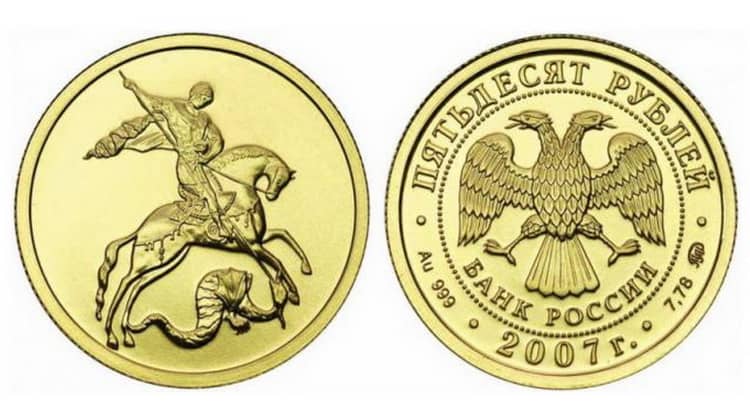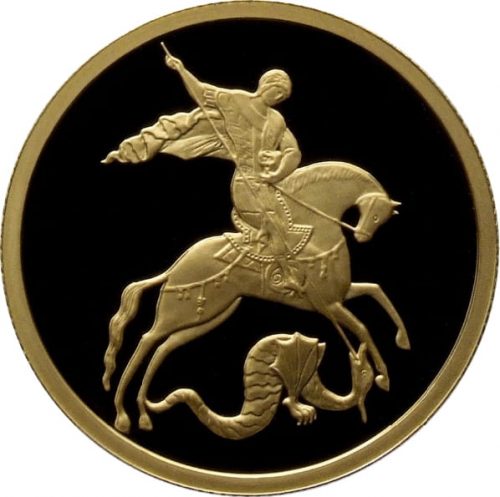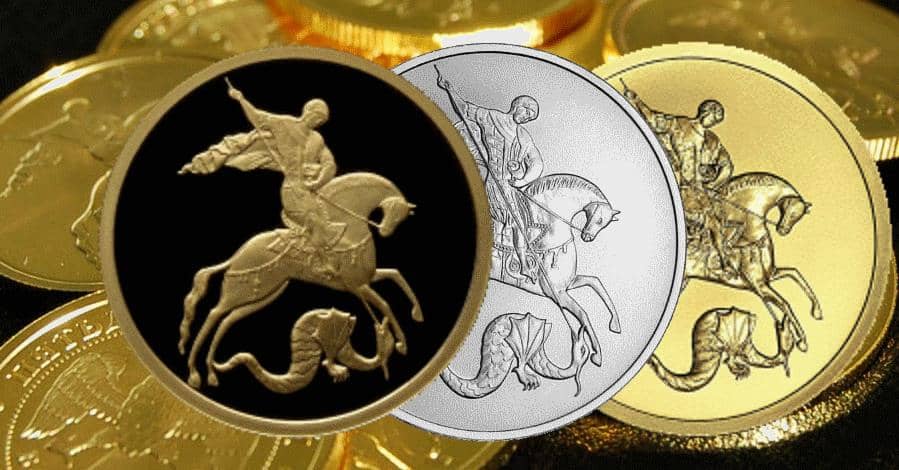
The Saint George the Victorious coin of 50 rubles denomination is a modern investment coin, issued in Russia starting from February 1, 2006 (small circulation in as Proof was released on August 1, 2012). The Central Bank issued the production, as the gold seeder “The Sower” ran out and the country needed a new investment coin for international procurement and financial affairs.
History
Investment coins in Russia appeared in 1922 due to the need to establish international trade with foreign countries. For this, the Central Bank of the country ordered at the Mint of St. Petersburg and Moscow the coinage of the “Sower” − a gold coin with the image of the national emblem of the Russian Federation on one side, and on the other − a peasant sowing grain. Over time, the stocks of coins were depleted and it took the minting of a circulation with a new design − for this purpose Saint George the Victorious was chosen.
Did you know? The gold coin is named in honor of Saint George the Victorious, a Roman soldier-officer, famous in legends and revered by Christians. George, who was born in 275-281, went to serve as a soldier in the Roman army. Later he became world-renowned Christian martyr. This happened after he was beheaded on April 23, 303 due to disobedience to his emperor. He refused to renounce the Christian faith. In those times, firm determination was respected and respected by Christians.
The image of Saint George the Victorious is used not only in national symbolic, but also in the symbolic of many European countries. The English Sovereign coins have an image of a Saint, so new investment coins were viewed positively on the international market. The “Sower” coins in the early years of coinage (in 1922) were not accepted in many states, because they contained Soviet symbols, which were unacceptable at that time. The production of chervonets had to be curtailed, instead of it (until 1975) they continued to produce coins with the image of the Tsar (by stamp 5 rubles 1898–1911 and 10 rubles 1898–1911).
Did you know? The image of Saint George the Victorious have been minted at all times. Old samples are known in Russia − copper 2 kopecks of 1757-1761, issued during the reign of Empress Elizabeth of Russia. On the reverse side there is a story familiar to many − the saint spears the snake. Under the picture there is a ribbon on which the denomination is noted. The coin was minted at several Mints, so the images and the herd were different (sometimes so horrible that it was difficult to make out the portrait of Saint George the Victorious). The copper samples of 1757 are almost identical in value with modern investment coins of gold.
The minting of the gold Saint George the Victorious coin was performed at two Mints:
- SPMD − St. Petersburg Mint
- MMD − Moscow Mint.

The abbreviation of production is indicated on one of the sides. Information partly determines the value of an investment coin, according to which it can be sold to a bank. The fact is that the Saint Petersburg Mint produced “Saint George the Victorious”, which was damaged − there were oxidations, spots, dents and patina on its surface, which is not typical for modern gold and silver coins of Russia. The cost of rubles with the abbreviation SPMD may be less than with MMD.
The gold coins of Saint George the Victorious of 50 rubles denomination were minted from 2006 to 2015. Their attractiveness was so indisputable that in the same period they produced a silver equivalent with a denomination of 3 rubles (2009, 2010 and 2015) and a gold coin of 100 rubles denomination (2012). The Central Bank is planning to continue production and annually issue of new lots of 50 ruble investment coins.
Design
Saint George the Victorious gold coins of all years of release have the same design (including as a Proof). On the front side there is a circle framed by a beaded rim. Inside there is a symbol of the Bank of Russia − a double-headed eagle with wings lowered. Under the emblem there is an inscription “BANK OF RUSSIA” in a semicircle.
Did you know? A double-headed eagle is minted on the obverse of the gold coin of Saint George the Victorious. His image was created by the famous Russian illustrator and revolutionary Ivan Bilibin. The design was developed immediately after the overthrow of the King (in 1917). The eagle of Bilibin is essentially the same as the imperial two-headed eagle, which served as a symbol of Russia. The only difference from the imperial symbol is the absence of crowns on both eagle heads.
The following inscriptions follow the circumference in order:
- Denomination of the coin “FIFTY RUBLES”
- Trademark (MMD or SPMD)
- Mass of the metal in its pure form (7.78 g)
- Year of issue (since 2009 -…)
- Sample (999 sample)
- Metal for embossing (Au).
On the reverse side is the image of Saint George, who strikes the snake with a spear. The relief is also surrounded by a rim of edging. The author of both images is the national artist of Russia A.V. Baklanov.

General characteristics of the coin:
- Quality of embossing − Uncirculated
- Sample − 999
- Total mass in grams – 7.89 (0.1 gram error is allowed)
- Minimum content of pure gold − 0.25 troy ounces
- Diameter − 22.6 mm
- Thickness −1.6 mm
- Edge − 134 ribbings
The gold coins of Saint George the Victorious of 50 rubles denomination as a Proof have exactly the same characteristics.
Circulation
In total, the Central Bank of Russia issued 5,250,000 samples of coins made of precious metals (from 2006 to 2015). Most of them are commemorative gold and silver coins. The Proof circulation were produced in limited quantities. The first circulation of investment gold coins of Saint George the Victorious, made on February 1, 2006, consisted of 150,000 samples. In subsequent years, they were minted as needed, and so on until 2015.
Did you know? Gold is the most popular precious metal for investment, especially when it comes to investment coins (as opposed to bullion, buying / selling is not taxed). It was used throughout history as currency, it also served as a standard for currency equivalents, characteristic for different countries. Many European countries introduced the gold standard in the 19th century, until innovation was temporarily suspended during financial crises associated with the World War I.
The number of investment coins of St. George by year:
- 2006 − 150,000 pcs .
- 2007 − 1,130,000 pcs .
- 2008 − 630,000 pcs .
- 2009 − 1,500,000 pcs .
- 2010 − 640,000 pcs.
In 2011, in the production of gold Saint George the Victorious coins of 50 rubles denomination, was made a temporary break. Embossing continued in 2012-2015. During this period, coins were issued as a Proof with a circulation of 10,000 samples.

Cost of coins
Saint George the Victorious gold coins with a denomination of 50 rubles are made of precious metal, which means their value is determined by the current exchange rate on the stock exchanges. If it is necessary to acquire new investment samples, then this can be done in 200 large banks of Russia. To do this, you need to have identification documents with you. The approximate cost is 370 $ USD, the exact price will be announced by a bank employee on the day of purchase.
A purchased sample of gold must be stored in a special container, do not get it out and not touch it, so the gold coin will retain its excellent appearance until it becomes necessary to sell it to a bank or an interested person. Any damage or fingerprints on the surface of the coin will reduce its value by 30%.
Comments
No commens yet.